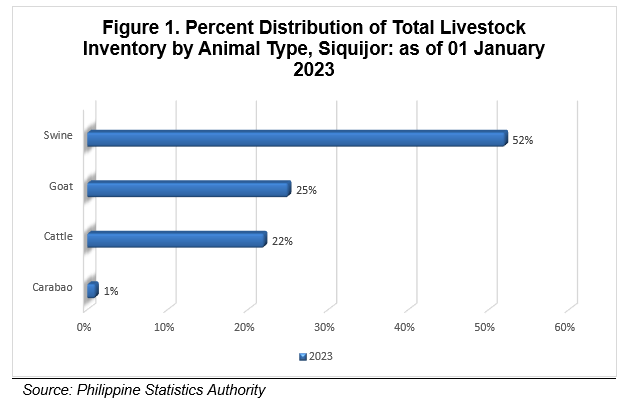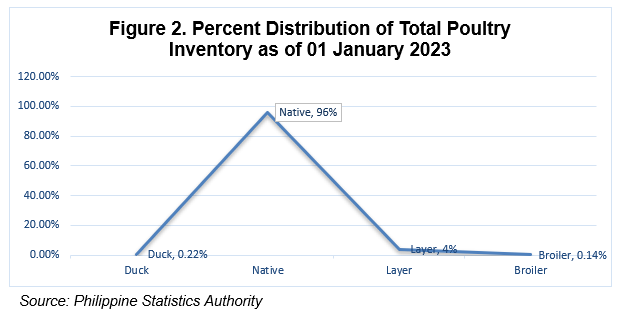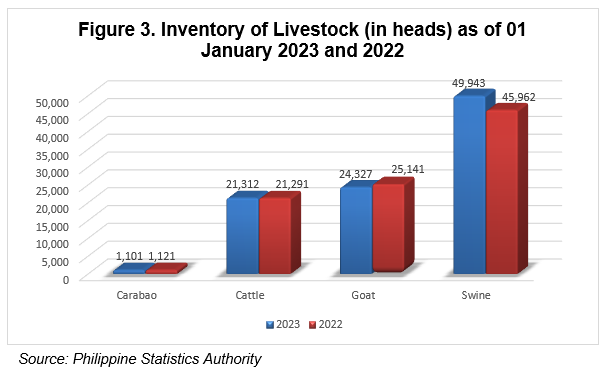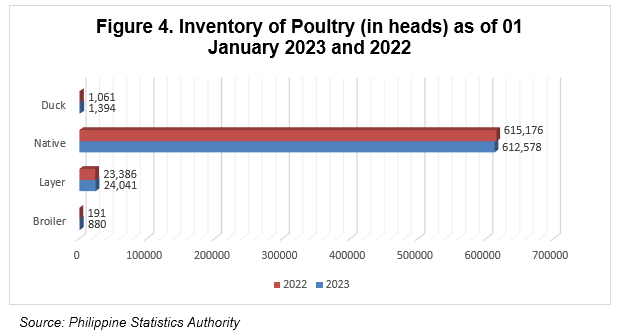As of 01 January 2023, total livestock inventory in the province reached 96,683 heads. This figure posted an increase of 3.39 percent compared with the inventory of 93,515 heads during the same period of 2022. This was attributed to the increase in the inventory of hogs and cattle.
By animal type, hogs accounted for the biggest share by 8.66 percent followed by cattle by 0.10 percent in the total livestock inventory of the province. Meanwhile, inventory in goat decreased by 3.24 percent followed by carabao by 1.78 percent.
For poultry inventory, the total inventory reached 638,893 birds in 2023. This was 0.14 percent lower than the previous year’s same period count of 639,814 birds. Population of broiler chicken significantly increased by 360.73 percent and layer chicken by 2.80 percent. The inventory of ducks also increased by 31.39 percent. Meanwhile, native/improved chicken stocks reported reductions of 0.42 percent.


Swine recorded the largest share accounting for 52 percent in livestock inventory, followed by goat, cattle, and carabao having a share of 25 percent, 22 percent, 1 percent, respectively.

Native chicken had the largest share in the poultry inventory contributing 96 percent while layer, duck and broiler shared only 4 percent, 0.22 percent and 0.14 percent, respectively.

Swine in backyard and commercial farms topped the inventory in all types of livestock with 49,943 heads in 2023 while carabao has the lowest inventory of 1,101 heads in 2023.

Native/improved chickens has lowered from to 615,176 heads in 2022 to 612,578 heads in 2023. On the other hand, broiler chickens significantly increased from 191 heads in 2022 to 880 heads in 2023.
TECHNICAL NOTES
The Livestock and Poultry Statistics of the Philippines publication presents data series on volume of production, inventory, number of animals slaughtered in slaughterhouses and dressed in poultry dressing plants, and average farmgate prices. It serves as a ready reference for the various clients and stakeholders of the Philippine Statistics Authority (PSA) in the agriculture sector.
The data for this report were collected by PSA through the two surveys, namely, Backyard Livestock and Poultry Survey (BLPS) and the Commercial Livestock and Poultry Survey (CLPS).
The BLPS aims to generate estimates on the supply and disposition of livestock and poultry commodities at the household level. In 2022, the number of sample households covered was 21,961 from the 1,145 sample barangays nationwide. On the other hand, the CLPS seeks to generate estimates on the supply and disposition of livestock and poultry commodities from sample establishments. There were 67 sample establishments for carabao; 176 sample establishments for cattle; 133 sample establishments for goat; 826 sample establishments for swine; 691 sample layer establishments and 892 broiler sample establishments for chicken; and 193 sample establishments for duck covered in 2022.
Both surveys are conducted quarterly in all provinces, including National Capital Region (NCR). Moreover, the commodities covered in the surveys include: cattle, carabao, swine, goat, chicken, chicken eggs, duck, duck eggs, and other animals raised/tended by households and establishments.
The data on the number of carabao, cattle, goat, hog, goat slaughtered in slaughterhouses and chicken dressed in poultry dressing plants were sourced from the Compilation of Data from Slaughterhouses and Poultry Dressing Plants (CDSPDP), an administrative-based activity of the PSA. This activity covers 1,281 Licensed to Operate Meat Establishments (LTOMEs) and Locally Registered Meat Establishments (LRMEs) nationwide. This is undertaken in coordination with the National Meat Inspection Service (NMIS) and the Local Government Units (LGUs).
Definition of Terms
• Production – refers to the volume of indigenous (locally-raised) animals disposed for slaughter which includes animals exported or shipped-out for slaughter (in “head” and in “live weight equivalent”)
• Livestock – farm animals kept or raised for consumption, work or leisure. In general, poultry is separated as a distinct group of farm animals. For purposes of census and surveys, livestock covers only those that are tended and raised by an operator.
• Poultry – a collective term for all domesticated avian for the purpose of food consumption, or the carcass of such avian dressed/processed for human consumption.
• Animal Inventory – (also Animal Population) – the number of domesticated animals in the head present in the farm at specific reference date.
(SGD.) JOSELITO C. MAGHANOY
(Supervising Statistical Specialist)/
Officer-in-Charge

